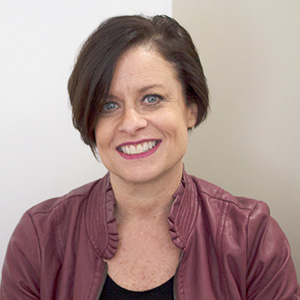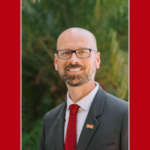A career in human resource management involves strategic planning, addressing ever-changing legal and ethical issues, managing complex budgets, and guiding organizational behavior and change.
Whether you’re new to HR or an accomplished practitioner, SDSU’s Human Resource Management Professional Certificate helps you advance your career by acquiring the necessary skills, and providing practical experience.
 Meet Instructor Dari DeSousa
Meet Instructor Dari DeSousa
By day, Dari DeSousa is director of Human Resources at RAR Hospitality, a San Diego-based hotel management company. By night, she teaches the Talent Acquisition course in the Professional Certificate in Human Resource Management program through SDSU’s College of Extended Studies. In between, she’s cultivated interests that one wouldn’t necessarily equate with an HR professional.
“I think it surprises students when they find out that I’m kind of a geek and love zombies and Comic-Con,” said DeSousa, who will also be team teaching the Compensation course in HR along with fellow Marriott employee Dawn Myers during the fall semester.
What are some highlights of the Talent Acquisition course?
My favorite night is when we review, create, and practice interview questions. It’s a great brainstorming session. We do activities to think outside the box and come up with interesting questions that will gain insights into candidates. Students get to “interview” each other, putting their questions into practice. The most interesting question from another company we saw: “Tell me all the uses for a brick in one minute. ” This would show quick thinking, creative thinking; a bit of a stress test.
Here are two questions from our interview bank: If you were a Disney character, who would you be and why? Who would win a bowling match between Oprah and Abraham Lincoln, and why?
My second favorite night is our “Human Capital Review” session. Human Capital Planning is a passion of mine, so I’m naturally drawn to the fun dialog of the session. This is a topic that isn’t entirely familiar to people, but the tools we learn are things that they can take with them. HCR is growing your bench into leadership roles, forecasting future open positions, and ensuring a succession management plan to backfill talent.
Tell us more about growing your bench and backfilling talent.
Bench is like a football analogy. What are you doing to grow your second-string if the first string gets injured/traded, etc.? So when you’re looking at leaders, you need to actively review who may be looking to transfer, get promoted, retire, etc. Then you review and determine who’s next, or on the bench, and then have development plans in place to ensure that over time, this next group are ready to fill the positions as they open. That’s what “backfill” means. This bench, ideally, is being developed to take the role of departing leaders.
The reason all of this can be so important is time and money. Sourcing talent, from scratch, from outside of your organization takes time, and the productivity loss can also then result in a higher cost to the organization. Additionally, having a strong bench, with strong development plans in place really engages the workforce and helps with loyalty and a sense of career, versus “just having a job.”
What will students learn in your class that they didn’t know before?
Even if they have experience hiring, they will leave the class with new tools in their belt for recruiting; they will have an opportunity to work on their own resume; and they will have a great outline to begin their own Human Capital Review process.
Does the course require homework outside the classroom?
Yes. There is reading, one presentation, and a small paper. Additionally, there are small, time-easy homework tasks.
What have you learned about your students?
This was my first class at CES. I really enjoyed this group not only as students, but as HR and future HR professionals. I thought everyone was engaged, and their participation really made for some interesting and dynamic conversations! One particularly interesting conversation started with a discussion on Gravity Payments CEO Dan Price when he cut his salary. That went to a dialog on Amazon and Zappos, who both have a “pay to quit” program. [EDITOR’S NOTE: The goal of this novel concept is to filter out disengaged employees.] It wasn’t a part of the planned lecture, but it was such a good conversation, we ran with it!
What’s the most interesting aspect of HR?
The people. I love teaching and developing people to help them in their careers and to be amazing leaders. I also love the “tough stuff.” I find it always an interesting challenge sorting through formidable or legal situations.
Where do you think the HR profession is headed?
I feel that compliance is going to have to be a focus point. Every year, especially in California, there are more and more laws that we have to ensure are correctly followed to keep our companies litigation- and fine-free. I also think that Human Capital will be essential. Many companies have flattened their leadership structures, leaving the bench a bit lean. Developing talent will be key for succession planning and keeping your leadership levels consistently strong.
What advice do you have for those seeking to enter the HR profession?
Make sure you LOVE it. Not like it; L-O-V-E. This field is a passion; go all-in or find a better-suited field. This doesn’t mean you will love every aspect or every day. But overall, you need to have passion to maintain the energy to navigate the HR waters.
 Meet Instructor Dawn Myers
Meet Instructor Dawn Myers
Borrowing from a popular ad campaign, Dawn Myers believes that whatever happens in her class, stays in her class. To find out what that is, you’d have to take Myers’ Introduction to Human Resource Management course at SDSU’s College of Extended Studies.
Former student Gladys De Santiago did, and can’t say enough good things about Myers. Having worked in the HR world for many years, De Santiago didn’t expect to learn anything groundbreaking from the course. Little did she know that she was about to meet and be taught by “one of the most amazing and accomplished people in the HR world.”
“This class has motivated me to continue on with my goals and dreams,” De Santiago said. “I’ve learned so much from Dawn and her generosity of time. I appreciate her realistic approach to the materials given.”
Myers, director of human resources at the San Diego Marriott Gaslamp Quarter, will also be teaching the Compensation course in the fall with fellow Marriott employee Dari DeSousa.
Myers has worked the past 13 years for the hotel, which has been voted among San Diego’s “Top Places to Work” for each of the past 10 years.
What does your job at the San Diego Marriott involve?
I’m directly responsible for the overall administration, coordination, and evaluation of the human resource function of our hotel. Simply put, if it involves an associate, it involves me.
How did you become an instructor at SDSU’s College of Extended Studies?
I was serving on the board for the Extended Studies’ program and the director put out a request for instructors. Because I love to see people grow, I answered the call.
How often does your class meet and is there homework?
Once a week, from 6 to 9:30 pm. Yes there is homework, but I understand that many students have full-time jobs so the work outside of the classroom is not extensive.
Do you use your own experiences in teaching the class?
Absolutely, that is what the students want to hear and that is when they learn the most … from my failures and successes.
What have you learned about your students?
That we all have something to learn from one another. I may be the instructor, but I learn about different industries, cultures, and viewpoints every week. It’s priceless and I feel honored to be a part of such a collaboration.
Any fun or interesting anecdotes to share from class?
“HR Circle of Trust” – what happens in class stays in class. I guess you’ll have to take my class to find out.
Who should take this class?
I would recommend the Introduction to Human Resource Management course for anyone who is remotely interested in HR. I tell my students in the very beginning “by the end of this class you should hold your head high with confidence and say ‘yes, I want to be in HR’ or you will run away from here screaming.” If you do either one of those things, I’ve done my job well.
What advice do you have for those seeking to enter the HR profession?
It’s all about relationships. You can’t be in human resources and be in a silo. You have to network and reach out to people for help and insight. SDSU’s HR Certificate program is one way to do that.”




